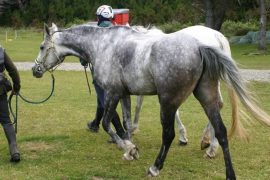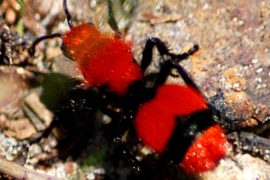Brush algae, like all algae in the aquarium, are caused by an imbalance. In this case, there is a nutrient imbalance. The unloved type of algae occurs mainly when fertilization is too high, especially when iron fertilization is too high. But other factors can also promote the growth of brush algae. You can find out what these are and how to get rid of the algae here.
Brush algae – appearance and behavior in the tank
Brush algae belong to the group of red algae. Their color palette ranges from deep black through all shades of gray to dark green. Visually, brush algae resemble small brushes and have a bushy appearance.
One thing brush weed has in common with bearded is that they mostly attach themselves to hardscape – i.e. to furnishings and decorative objects that are more or less static in the tank. They are very tight and difficult to remove.
The housing of internal filters, stones, or roots is therefore the preferred settlement site for brush algae. Brush algae also love places with strong currents. Occasionally they also grow on slow-growing plants such as Anubias and Microsorum. They usually cannot be plucked off without damaging the leaves of the aquarium plants.
Identify red algae
A simple test to determine whether the “subtenant” is a red alga: put a sample of the alga in alcohol. If the alga turns red, then it is a red alga. Their growth habit should then facilitate further identification.
Common causes for the appearance of brush algae
Brush algae can be found in all types of aquariums – they conquer densely planted aquascapes as well as sparsely planted fish tanks. However, brush algae do not seem to spread through flying spores. If they suddenly appear in the aquarium, they have definitely been brought in by plants, decorations, or water from other aquariums.
Three factors favor the mass spread of this stubborn algae:
Pollution of the water
In pure fish tanks with a high stocking density and only sparse planting, the black brush algae often occur. Heavy feeding and the resulting high organic load, possibly favored by too few or too few water changes, create conditions in which the black brush algae feel very comfortable.
Another possible reason for the occurrence of brush algae is the accumulation of sludge in the substrate or in the filter. The simplest way to counteract this is to clean the soil from sludge by vacuuming or washing out the filter material.
Low carbon dioxide content
The lack of a CO2 system can also be responsible for the occurrence or growth of brush algae. The level of free carbon dioxide (CO2) in the water plays an important role in the occurrence of brush algae. If the aquarium water contains too little CO2, red algae and thus also the brush algae are able to satisfy the need for carbon from hydrogen carbonate much more easily than higher aquatic plants.
Hydroxide ions are formed by splitting off the carbon from the hydrogen carbonate ion, which increases the pH value. This triggers what is known as biogenic decalcification: Lime (calcium carbonate) is released, which the brush algae build into their cell walls, making them harder and less attractive to predators.
High iron content
If fertilizer is used with a complete iron fertilizer, it is advisable to reduce the amount. With a reliable test method, the iron content should be tested. If the aquatic plants develop very light shoot tips when the brush algae appear – a sign of iron deficiency – we recommend switching to a weaker complete iron fertilizer. It may be worth switching to pure iron fertilization without trace elements.
Brush algae and the solution to the problem
The right fertilizer for brush algae
If brush algae have spread in your aquarium, you should only use complete iron fertilizer very sparingly. Only use it when the taller plants show signs of deficiency in the form of yellowish leaves.
For fertilization we recommend instead:
- Plant Growth Premium (a complete fertilizer for aquatic plants from Tropica)
- Plant Growth specialized (an iron-free macronutrient fertilizer from Tropica)
Control of brush algae
You can also combat brush algae directly. Easy Carbo from Easy Life is suitable for this, which you simply add to the aquarium. According to the manufacturer’s instructions, use 1 to 2 ml per 50 liters of aquarium water.
After a few days of treatment, the brush algae should take on a whitish to pink color. Now you can stop the treatment. The dead algae can now be eaten by algae-eating aquarium inhabitants, such as ramshorn snails or Amano shrimp.
Fogging with Easy Carbo or hydrogen peroxide offers a more targeted application.
Draw a usual daily dose into a syringe and spray brush algae directly under water. Filters or flow pumps should be switched off for a few minutes. Please note, however, that sensitive plants – especially mosses – can react sensitively to the treatment.
Preventive measures against brush algae
The course of brush algae spread is always the same. If you walk through the pet shops with your eyes wide open, you will often notice decorative objects in poorly maintained facilities, which are overgrown with brush algae on the edges. Due to the often common central filtration and non-disinfected nets, the algae are spread throughout the facility.
If you transfer an “infested” stone or a root from such a system to a previously brush algae-free tank, the algae show up after a while first in the areas exposed to the current. The filter spout is very popular here. When the algae reach a certain age, tiny spores are formed, which spread throughout the tank and colonize any suitable spot. If at all, the fight can only be won with radical measures.
The spread can also be counteracted by preventive measures.
UVC sterilization has proven to be particularly effective. The water is run through a UVC sterilizer, killing the algae spores.
Combat brush algae with UVC sterilizers
There are these devices for aquariums and for garden ponds. The sterilizers for ponds are significantly cheaper. We use devices with 5 to max. 11 watts. The effect is amazing. The water is crystal clear after a few days and no new brush algae settle. The older algae foci are removed as far as possible. Affected plants are either treated with Easy Carbo or replaced completely.
Decorative objects can be taken out of the basin, rubbed with salt, and brushed thoroughly under running water after a day.
For the future:
- never, never, ever put objects or plants from aquariums with brush algae into your own tank.
- When introducing fish, never pour the water into the aquarium.
- Always disinfect landing nets from “brush algae aquariums” or only use them for these aquariums.
We hope that our information and tips will help you to combat brush algae.
What are your experiences with brush algae? We are looking forward to your comments!





